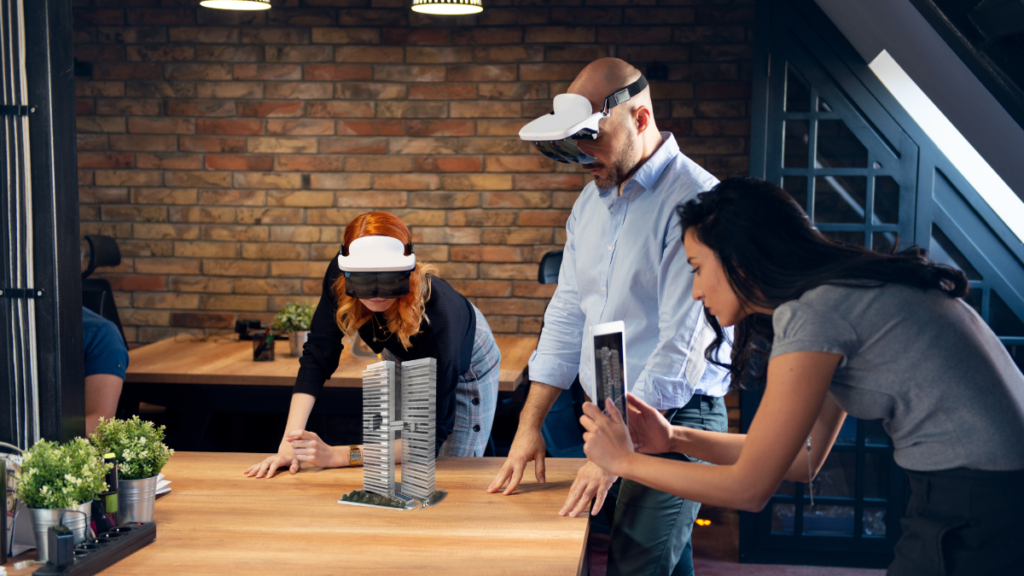It started with a coffee and a crayon.
A founder sat in the corner of a café, sketching ideas on a napkin while watching a kid across the room play with their phone. But this wasn’t any regular game. The child was pointing the phone at the table, giggling as cartoon characters popped up from the surface — dancing, stacking virtual blocks, even waving.
No wires. No headset. Just a screen and a little imagination.
That moment stuck. The founder didn’t see a toy. They saw a tool.
Something clicked — if a six-year-old could interact with digital objects like they were part of the real world, what could that mean for customers, for teams, for businesses that needed to do more than just show up?
That was the first spark. Not a pitch deck. Not a demo. Just curiosity.
And that’s how a lot of AR stories start — not with tech, but with a problem waiting to be solved in a more human way.
So if you’re an entrepreneur looking to build something that feels natural, useful, and just a little bit magical… you’re in the right place.
Why AR feels like magic—but shouldn’t be treated that way
There was a time when people saw augmented reality as a party trick. Floating dinosaurs in living rooms. Glitter filters on selfies. It felt fun. Flashy. But not serious.
Then came a moment no one really expected — a mobile game with cartoon creatures changed the business world without even trying. Pokémon Go didn’t invent AR, but it made people notice. Suddenly, millions were walking around cities chasing digital characters, phones held up like compasses. And for once, nobody was asking, “What’s the point?” The point was the experience.
That shift — from spectacle to utility — is what opened the door.
Now, AR isn’t just tucked inside games. It’s showing up in places most people don’t even realize:
- Drivers scanning car dashboards that update in real time.
- Shoppers using their phones to see how a bookshelf fits their apartment wall.
- Field technicians walking through repairs with step-by-step AR instructions floating over the machinery.
The tech doesn’t need to shout anymore. It’s becoming quieter. More embedded. And that’s the moment entrepreneurs should pay attention.
Because once a technology stops drawing attention to itself, that’s usually when it becomes powerful. Not as a gimmick. Not as a buzzword. But as something people start to rely on without thinking about it.
And the window is still open. That’s the opportunity.
What makes AR a practical tool for entrepreneurs
Think of AR as a way to layer information on top of the real world — not through wires or goggles, but through the devices people already use every day.
It’s not theoretical. It’s already solving real problems.
A furniture startup lets customers scan their living rooms and drop in a virtual couch. No imagination needed — they can see if it fits, if the color clashes with the rug, if it even makes sense in the space. Fewer returns. Faster decisions.
A beauty brand rolls out a virtual try-on feature. Customers swipe through lipstick shades in real time, right from their phones. They spend more time browsing. More likely to click add to cart.
A home repair service uses AR to walk customers through simple fixes. Point your camera at the broken thing, and arrows appear. Turn this. Check that. It reduces the number of technician visits — and builds trust.
AR isn’t about showing off what your product could do. It’s about removing friction, reducing uncertainty, and helping people act faster with more confidence.
That’s the real magic.
Finding the right use case for your business

Not every AR idea is a good one. The tech might be impressive, but the question is always the same: Does it solve a real problem?
There’s a story about a boutique retailer that installed AR mirrors so customers could “try on” clothes virtually in-store. It turned heads. People took photos. But after a few weeks, most shoppers ignored the mirrors and went back to the fitting rooms.
What worked better? An AR-powered staff training app. New employees could scan store sections to get instant tips on display setup, folding standards, and restocking protocols. It saved managers hours and kept things consistent across shifts.
That’s the difference between building for attention and building for value.
If you’re thinking about adding AR to your business, start with a few grounded questions:
- Where are your customers getting stuck?
- What decisions are they hesitating on?
- What parts of your product are hard to explain without a demo?
The best AR experiences aren’t loud. They’re useful. They make the invisible visible. They help people understand something faster.
You don’t need to overhaul your entire business. One strong use case is enough to test the waters.
Start small. Listen to the response. Let the data and behavior guide what comes next.
What you actually need to start (tech, budget, team)
You don’t need a massive dev team or millions in funding to bring an AR idea to life. But you do need to know where to start — and what not to waste your money on.
Some founders build their first AR experience using tools like Spark AR (for Instagram and Facebook) or WebAR platforms that work straight from the browser. No app downloads. No friction. Just a link, a camera, and a simple experience layered on top of the real world.
Others team up with small dev studios or freelancers who specialize in AR. You don’t need a unicorn engineer — you need someone who understands both the technical side and how users behave in physical spaces.
Budgets can vary wildly. A basic AR filter or prototype might cost a few hundred dollars. A custom-built WebAR product demo could land in the $10K–$25K range. Full-scale app integration? That’s a bigger bite — but it’s not always necessary at the start.
There’s a great example of a solo founder who mocked up an AR feature using paper cutouts and an Instagram filter. That scrappy demo didn’t just land them early users. It got them investor meetings.
The point is, you don’t have to wait until everything is polished. You need something that works well enough to test the concept.
Useful. Functional. Shareable.
That’s where momentum begins.
The pitfalls that get in the way (and how to dodge them)
The biggest mistake? Building something cool that no one needs.
It happens all the time. A founder gets excited about AR and races to launch a flashy experience — but forgets to ask if anyone actually wants it. It ends up buried on a landing page, collecting dust, ignored by users who were looking for something else entirely.
There’s also the UX trap. Just because you can overlay a ton of visual elements doesn’t mean you should. Too much clutter, slow load times, awkward camera angles — it all breaks the experience. And people don’t give second chances when tech feels clunky.
Then there’s the temptation to do everything at once. A product preview. A virtual guide. A gamified tutorial. The more you cram into it, the harder it is to maintain — and the less clear the value becomes.
The fix? Start with one real-world problem. Solve that cleanly.
Talk to users before you build. Mock things up on paper. Test with five people before launching to five hundred. Strip away the extra layers until what’s left feels obvious.
When AR feels like it belongs — when it fits into the user’s day without asking too much — that’s when it sticks.
Future-proofing your AR idea without overengineering it
It’s tempting to chase what’s next.
AR glasses. Spatial computing. Mixed-reality everything. The tech headlines promise a lot — and some of it will happen. But most of it won’t happen as fast as people think.
What’s already shifting is more practical.
WebAR is getting smoother. No apps, just a browser link that loads instantly. Apple is baking AR deeper into its ecosystem. Meta is pouring money into making AR part of daily life — not just entertainment.
This matters because the groundwork is being laid now. But that doesn’t mean you need to build for five years from now. You need to build for today, with enough flexibility to grow later.
That might mean:
- Choosing platforms that don’t lock you in.
- Working with tools that support both mobile and headset use.
- Designing experiences that still function even if the AR layer disappears.
AR should never be the only way people can use your product. It should be the most helpful way — when it makes sense.
Build like your users are on their phones today. Because they are.
But be smart enough to keep one eye on what’s coming.
Build for people, not for trends
It always comes back to that founder in the café.
What they saw wasn’t cutting-edge tech. They saw a moment — a small interaction that felt effortless and human. That’s what stuck. Not the code, not the platform, not the device.
If you’re building with AR, the goal isn’t to impress. It’s to help.
Help someone make a decision faster. Help them learn something better. Help them feel closer to the thing you’ve created.
The trend-watchers will always be chasing the next big thing. Let them. Your edge comes from noticing the small problems no one else is solving — and using AR to solve them in a way that feels natural.
Start where the friction lives. Strip away the noise. Build something that makes sense the moment someone uses it.
Because the best AR doesn’t demand attention.
It earns it.




